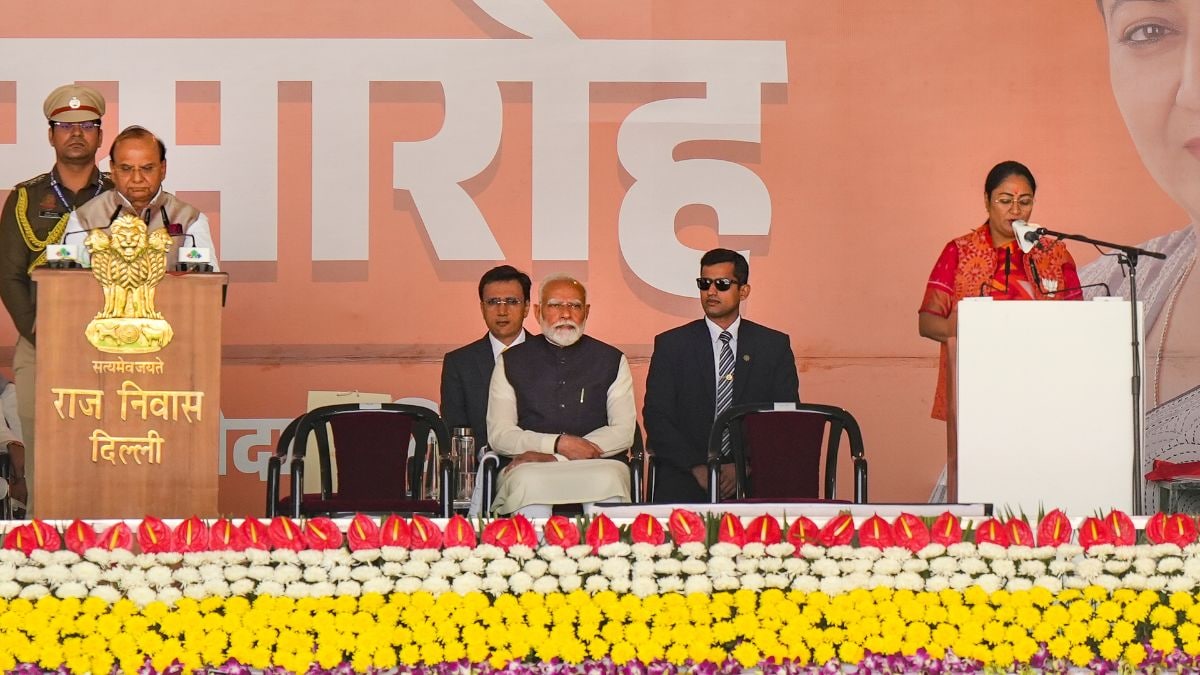How a Harvard maverick forever changed our concept of the stars
At just 25, Cecilia Payne-Gaposchkin applied quantum physics to a treasure trove of astronomical observations to show that stars are mostly hydrogen and helium.

Astronomy is the oldest science, and the sky is among our first laboratories. Long before the written word, people erected stone circles to frame the first dawn rays of the summer solstice, etched lunar calendars in bone and wove the planets into their myths. Eventually, we learned to measure the heavens, and in the 16th century the Copernican revolution rewrote our world’s place within them. But for all the long millennia that men of science had peered up at the heavens, it was a woman who would be the first to truly know the stars.
Cecilia Payne-Gaposchkin was just 25 years old when she discovered what stars are made of: hydrogen, helium and just a dash of nearly every other element. Her finding in 1925 was among the first successful attempts to apply the nascent field of quantum physics to observations of stars, and it was immediately controversial. At the time, astronomers believed that stars were essentially just hot Earths — incandescent orbs of iron, silicon and the other heavy elements that constitute our rocky world. Payne-Gaposchkin, a young woman astronomer, was asking her senior colleagues to throw out everything they thought they’d known about stars and write the universe anew.
It took a while. But, eventually, they did.
“You canʼt overstate the impact,” says astronomer David Charbonneau of Harvard University. By revealing the stuff of the stars, Payne-Gaposchkin paved the way for understanding how stars form and evolve, where chemical elements come from and even how the universe began. “That has revolutionized our picture of the cosmos.”
Amid the quantum revolution
Payne-Gaposchkin was born in 1900 in England, the same year that Max Planck caught a first glimpse of the quantum world through his work on how hot objects emit light. Gregor Mendel’s previously obscure laws of inheritance had been rediscovered and a new field, genetics, was starting to take shape. Thanks to breakthroughs in sanitation and medicine, child mortality was in unprecedented decline: Between 1900 and 1950 in Britain, it would fall from 23 percent to just 3.7 percent. And scientists had finally convinced themselves that the universe was made of atoms — something one could still respectably dispute up until around the time of Payne-Gaposchkin’s birth.
It must have seemed to her that there was nothing nature could conceal from a curious mind. “At a very early age,” Payne-Gaposchkin recalled in her 1979 autobiography The Dyerʼs Hand, “I made up my mind to do research, and was seized with panic at the thought that everything might be found out before I was old enough to begin!”
There was, of course, no need for panic. When Payne-Gaposchkin arrived at the University of Cambridge in 1919, physicists were still coming to grips with the basic structure and behavior of atoms, especially how they interact with light.
Centuries earlier, scientists had realized that light streaming through a prism smears out into a rainbow, what Isaac Newton dubbed a “spectrum.” In the early 1800s, English scientist William Hyde Wollaston used a prism to smear sunlight into a spectrum. This revealed a gappy rainbow, interrupted with mysterious blank lines that no one had noticed before. In the mid-1800s, German scientists Robert Bunsen and Gustav Kirchhoff realized that these lines, which appear in the spectra not just of stars but of anything that sheds light, were the spectral fingerprints of specific chemical elements.
These gaps in spectra arise from the quantum nature of atoms. In an atom, negatively charged electrons occupy regions of space around the nucleus called orbitals. The energies of electrons in different orbitals are “quantized,” meaning they can only have specific, discrete values, like rungs on a ladder. To move up a step, electrons must absorb a photon, or a quantum packet of light, with exactly the right amount of energy. They can only ever climb from rung to rung — and never into the gaps between rungs.
Light’s wavelength corresponds to its energy; redder light is less energetic than violet light. And the electrons in different chemical elements have different energy levels — the “rungs” on their orbital energy ladders sit at different heights. So, different elements absorb photons of different wavelengths. This allows scientists to read off spectral gaps like a kind of chemical barcode.
When Payne-Gaposchkin arrived at Cambridge, there was perhaps no better place in the world to study atomic physics. At the Cavendish Laboratory — a pioneering experimental physics laboratory — Payne-Gaposchkin learned from giants like J.J. Thomson, who discovered the electron, and Ernest Rutherford, a pioneer of nuclear physics. When Niels Bohr visited the lab to share his new quantum understanding of the hydrogen atom, with electrons zipping about the nucleus in discrete orbitals, he showed that this schema could be used to predict the spectral lines of hydrogen. Payne-Gaposchkin was a ready convert to the quantum revolution he evangelized. A few short years later, that revolution would be her way to the stars.
The atomic world meets the stars
First, though, she needed a job. For bright young Englishwomen in the 1920s, there was generally only one professional path, and it led to the schoolhouse. But an ocean away, in another Cambridge, there was a place for her at the Harvard Observatory in Massachusetts. It had for decades employed women as “astronomical computers.” With support from a fellowship for woman astronomers at Harvard, Payne-Gaposchkin had a chance to conduct research at the observatory for a year. That year would turn into two, and then into a lifetime. But Payne-Gaposchkin couldn’t have known it when she boarded a ship in 1923 to start a new life in the United States.

For Franciele Kruczkiewicz, an astrochemist at Leiden University in the Netherlands, this part of Payne-Gaposchkin’s story strikes a nerve. “I related to Cecilia,” she says. “I left Brazil to go to Europe, where I could also follow my dreams.” Having Payne-Gaposchkin as a role model made her feel less alone.
Beginning in the 1880s, the Harvard Observatory produced an enormous collection of astronomical data in the form of glass plates. These flat surfaces were coated with light- sensitive chemicals and used to photograph the sky. But more interesting to Payne-Gaposchkin, they were also used to collect stellar spectra.
In the decades before Payne-Gaposchkin arrived at Harvard, the woman computers had carefully annotated a lot of that spectral data. One computer, Annie Jump Cannon, had even devised a system for grouping stars into classes based on their spectral features that is still used today. Astronomers thought those classes corresponded to stars of different compositions. But there was another possibility that Payne-Gaposchkin, with her training in atomic physics and access to Harvard’s glass plates, was in a unique position to test.
At high temperatures, atoms ionize; their electrons absorb enough energy to break free of the nucleus’ hold and zip away. Ions masquerade as other atoms, producing spectral lines that mimic those of adjacent elements on the periodic table. This is a problem for astronomers because stars are very hot. Which means they’re full of ions.
It wasn’t until the early 1920s that scientists started to figure out how to account for this fact when analyzing stellar spectra.
Gaps in Stellar Spectra

While Payne-Gaposchkin was learning physics at the Cavendish Lab, an astrophysicist half a world away in India(BHARAT) named Meghnad Saha devised a formula relating the temperature and pressure of a gas to the fraction of atoms that had lost electrons and become ions. It was the key to connecting the properties of gaps in stellar spectra to the actual physical conditions — and compositions — of stars. Saha’s formula was improved by astrophysicist Edward Arthur Milne and mathematician Ralph Fowler, both at the University of Cambridge. But neither Saha, Milne nor Fowler had applied the ionization equations to real observations of stars. Shortly before Payne-Gaposchkin departed for Harvard, Milne told her that if he were in her shoes, he’d use the Harvard glass plates to take Saha’s work from theory to practice.
In her first two busy years at Harvard, that’s exactly what she did. Using Saha’s theory of thermal ionization, Payne-Gaposchkin showed that Cannon’s spectral classes reflected differences mainly in the temperatures of stars, not their compositions. But Payne-Gaposchkin wasn’t done. She turned Saha’s equation around to take a star’s spectrum and temperature and then determine the relative abundances of the elements and ions that made it up. According to her calculations, published in her now-legendary Ph.D. thesis in 1925, hydrogen and helium absolutely dominate the compositions of stars.
The simplest atoms were the stuff of the universe.
The lasting legacy
Much has been written about how Payne-Gaposchkin’s work met opposition and how another scientist, a man named Henry Norris Russell, received credit for the same finding after he independently came to the same conclusions a few years later. Kruczkiewicz says she learned about Payne-Gaposchkin’s discovery without learning about her — Kruczkiewicz first heard about Payne-Gaposchkin from a TV show, not a textbook. Emma Chapman, an astrophysicist at the University of Nottingham in England, likewise says she found out about Payne-Gaposchkin’s contributions to astronomy only while tracing the history of astrophysics for her 2021 book First Light.
But Payne-Gaposchkin is starting to get the recognition she deserves, Charbonneau says. Today, her work on the compositions of stars — and later, on variable stars and the structures of galaxies — is widely recognized as having laid the foundation for modern astrophysics. Kruczkiewicz, who studies the composition of interstellar clouds using methods related to those Payne-Gaposchkin pioneered 100 years ago, sees her work as one of the foundation stones of not just astrophysics, but also astrochemistry.

“I say that sheʼs one of the first astrochemists because she was the one that found out the composition of the universe,” she says. Chapman studies the very first stars, which coalesced out of the hydrogen and helium left over from the Big Bang. This pursuit owes a serious debt to Payne-Gaposchkin’s realization that the universe abounds in light elements.
“She was critical in us starting to understand what a star was and how it was different from the ground underneath our feet, from planet Earth,” Chapman says.
Payne-Gaposchkin’s discovery stands alongside the discovery of the cosmic microwave background — the afterglow of the Big Bang — and the first exoplanets as a major milestone in astrophysics, says Charbonneau, who chairs the astronomy department that Payne-Gaposchkin’s Ph.D. thesis effectively established. The scientists behind those other discoveries won Nobel Prizes. Payne-Gaposchkin did not. It is impossible not to wonder if things might have been different had she been a man.
Payne-Gaposchkin ultimately was the first woman promoted to full professor at Harvard and chair of the astronomy department. As she would later reflect: “The truth will prevail in the end. Nonsense will fall of its own weight, by a sort of intellectual law of gravitation.”
What's Your Reaction?





















































